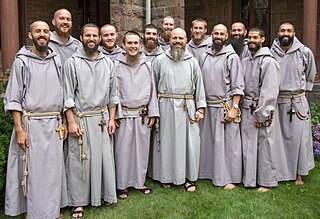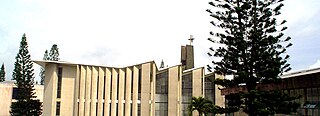Related Research Articles

The Franciscans are a group of related mendicant religious orders of the Catholic Church. Founded in 1209 by the Italian saint Francis of Assisi, these orders include three independent orders for men, orders for nuns such as the Order of Saint Clare, and the Third Order of Saint Francis open to male and female members. They adhere to the teachings and spiritual disciplines of the founder and of his main associates and followers, such as Clare of Assisi, Anthony of Padua, and Elizabeth of Hungary. Several smaller Protestant Franciscan orders or other groups have been established since late 1800s as well, particularly in the Anglican and Lutheran traditions.

The Order of Friars Minor Capuchin is a religious order of Franciscan friars within the Catholic Church, one of three "First Orders" that reformed from the Franciscan Friars Minor Observant, the other being the Conventuals (OFMConv). Franciscans reformed as Capuchins in 1525 with the purpose of regaining the original Habit (tunic) of St. Francis of Assisi and also for returning to a stricter observance of the rule established by Francis of Assisi in 1209.

The First Saturdays Devotion, also called the Act of Reparation to the Immaculate Heart of the Blessed Virgin Mary, is a Catholic devotion which, according to Sister Lúcia of Fátima, was requested by the Virgin Mary in an apparition at Pontevedra, Spain, in December 1925.

The Servite Order, officially known as the Order of Servants of Mary, is one of the five original mendicant orders in the Roman Catholic Church. It includes several branches of friars, contemplative nuns, a congregation of religious sisters, and lay groups. The order's objectives are the sanctification of its members, the preaching of the Gospel, and the propagation of devotion to the Mother of God, with special reference to her sorrows. The Servites friars lead a community life in the tradition of the mendicant orders.

Vincent Ferrer, OP was a Valencian Dominican friar and preacher, who gained acclaim as a missionary and a logician. He is honored as a saint of the Catholic Church and other churches of Catholic traditions.

The Third Order of Our Lady of Mount Carmel, also known as the Lay Carmelites, is a third order of the Carmelite Order of the Ancient Observance, established in 1476 by a bull of Pope Sixtus IV. It is an association of people who choose to live the Gospel in the spirit of the Carmelite Order and under its guidance. Its members are mainly lay people.

The Franciscan Friars of the Renewal is a Catholic clerical religious congregation of Pontifical Right for men founded in 1987. It follows the Capuchin Franciscan tradition.
A Catholic order liturgical rite is a variant of a Catholic liturgical rite distinct from the typical ones, such as the Roman Rite, but instead specific to a certain Catholic religious order.
The Third Order of Saint Francis is a third order in the Franciscan tradition of Christianity, founded by the medieval Italian Catholic friar Francis of Assisi.

A minor seminary or high school seminary is a secondary day or boarding school created for the specific purpose of enrolling teenage boys who have expressed interest in becoming Catholic priests. They are generally Catholic institutions, and designed to prepare boys both academically and spiritually for vocations to the priesthood and religious life. They emerged in cultures and societies where literacy was not universal, and the minor seminary was seen as a means to prepare younger boys in literacy for later entry into the major seminary.
In the Catholic Church, an association of the Christian faithful or simply association of the faithful, sometimes called a public association of the faithful, is a group of baptized persons, clerics or laity or both together, who, according to the 1983 Code of Canon Law, jointly foster a more perfect life or promote public worship or Christian teaching, or who devote themselves to other works of the apostolate.

The Divine Word Seminary Tagaytay (DWST) is a Roman Catholic mission seminary located in Tagaytay City, Philippines. Established in 1933, the seminary is owned and administered by the Society of the Divine Word. The primary purpose of the seminary is to prepare missionaries for both the Philippine and foreign missions. Its students are mostly seminarians preparing for the priesthood, and come from a cluster of around 14 autonomous affiliated houses of formation.

The Church of Our Lady of Sorrows is a Roman Catholic parish church in the Roman Catholic Archdiocese of New York, located at 105 Pitt Street between Rivington Street and Stanton Street in the Lower East Side of Manhattan in New York City. The area formerly served Catholics who lived in the immigrant enclave of Kleindeutschland.
The 233 Spanish Martyrs, also referred to as The Martyrs of Valencia or Jose Aparico Sanz and 232 Companions, were a group of martyrs from the Spanish Civil War, who were beatified in March 2001 by Pope John Paul II. This was the largest number of persons beatified at once up to that time. They originated from all parts of Spain but mostly served and died in the diocese of Valencia.

José María Amigó Ferrer was a Spanish Roman Catholic who served as the Bishop of Segorbe. He was also a professed member of the Order of Friars Minor - also known as the Capuchin order — and was also the founder of two religious orders: the Capuchin Tertiary Fathers and Brothers of Our Lady of Sorrows on 12 April 1889, and the Capuchin Tertiary Sisters of the Holy Family. He later assumed the name of "Luis from Masamagrell".

Francisco Xavier Ricardo Vilá y Mateu, OFMCap was a Spanish Capuchin friar and bishop of the Roman Catholic Church. He arrived as Guam's first bishop in 1911, and serving as apostolic vicar for less than a year, dying on 1 January 1913.
The Carmelite Sisters of Charity is a religious institute of pontifical right whose members profess public vows of chastity, poverty, and obedience and follow the evangelical way of life in common.

Robert Joseph Lombardo C.F.R. is an American Catholic prelate who has served as auxiliary bishop for the Archdiocese of Chicago since 2020.
References
- ↑ "Capuchin Tertiary Religious of Our Lady of Sorrows (T.C.)".
- ↑ "Capuchin Tertiary Religious of Our Lady of Sorrows (T.C.)".
- ↑ "Capuchin Tertiary Religious of Our Lady of Sorrows (T.C.)".
- ↑ "Capuchin Tertiary Religious of Our Lady of Sorrows (T.C.)".
- ↑ http://www. gcatholic.org/orders/178.htm
- ↑ "Capuchin Tertiary Religious of Our Lady of Sorrows (T.C.)".
- ↑ "Capuchin Tertiary Religious of Our Lady of Sorrows (T.C.)".
- ↑ "Capuchin Tertiary Religious of Our Lady of Sorrows (T.C.)".
- ↑ 12-3 Religious Tertiary Capuchins
- ↑ Religiosos Amigonianos "¿Qué hacemos?" Archived August 11, 2013, at the Wayback Machine (in Spanish)
- ↑ Religiosos Amigonianos: "Nuestra espiritualidad" (in Spanish)
- ↑ "Between Two Worlds", Bayer Magazine
- ↑ Religiosos Amigonianos "Nosotros-Familia" (in Spanish)
- ↑ Religiosos Amigianos: "Mártires" Archived August 11, 2013, at the Wayback Machine (in Spanish)
- ↑ Amigonianer: "Weltweit" (in German)